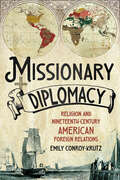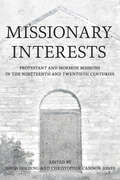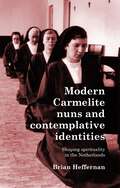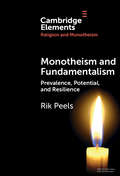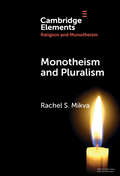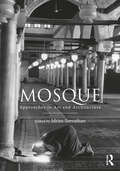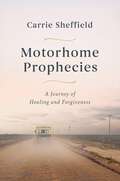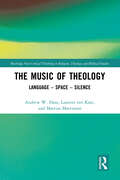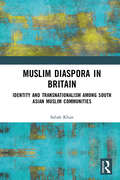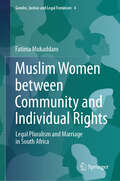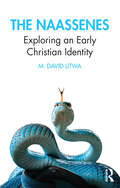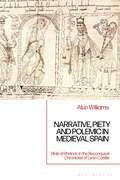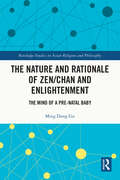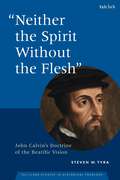- Table View
- List View
Mission Manifest: American Evangelicals and Iran in the Twentieth Century (The United States in the World)
by Matthew K. ShannonIn Mission Manifest, Matthew Shannon argues that American evangelicals were central to American-Iranian relations during the decades leading up to the 1979 revolution. These Presbyterian missionaries and other Americans with ideals worked with US government officials, nongovernmental organizations, and their Iranian counterparts as cultural and political brokers—the living sinews of a binational relationship during the Second World War and early Cold War. As US global hegemony peaked between the 1940s and the 1960s, the religious authority of the Presbyterian Mission merged with the material power of the American state to infuse US foreign relations with the messianic ideals of Christian evangelicalism. In Tehran, the missions of American evangelicals became manifest in the realms of religion, development programs, international education, and cultural associations. Americans who lived in Iran also returned to the United States to inform the growth of the national security state, higher education, and evangelical culture. The literal and figurative missions of American evangelicals in late Pahlavi Iran had consequences for the binational relationship, the global evangelical movement, and individual Americans and Iranians. Mission Manifest offers a history of living, breathing people who shared personal, professional, and political aims in Iran at the height of American global power.
Missionary Diplomacy: Religion and Nineteenth-Century American Foreign Relations
by Emily Conroy-KrutzMissionary Diplomacy illuminates the crucial place of religion in nineteenth-century American diplomacy. From the 1810s through the 1920s, Protestant missionaries positioned themselves as key experts in the development of American relations in Asia, Africa, the Pacific, and the Middle East. Missionaries served as consuls, translators, and occasional trouble-makers who forced the State Department to take actions it otherwise would have avoided. Yet as decades passed, more Americans began to question the propriety of missionaries' power. Were missionaries serving the interests of American diplomacy? Or were they creating unnecessary problems? As Emily Conroy-Krutz demonstrates, they were doing both. Across the century, missionaries forced the government to articulate new conceptions of the rights of US citizens abroad and of the role of the US as an engine of humanitarianism and religious freedom. By the time the US entered the first world war, missionary diplomacy had for nearly a century created the conditions for some Americans to embrace a vision of their country as an internationally engaged world power. Missionary Diplomacy exposes the longstanding influence of evangelical missions on the shape of American foreign relations.
Missionary Interests: Protestant and Mormon Missions of the Nineteenth and Twentieth Centuries
by Edited by David Golding and Christopher Cannon JonesIn Missionary Interests, David Golding and Christopher Cannon Jones bring together works about Protestant and Mormon missionaries in the nineteenth and twentieth centuries, charting new directions for the historical study of these zealous evangelists for their faith. Despite their sectarian differences, both groups of missionaries shared notions of dividing the world categorically along the lines of race, status, and relative exoticism, and both employed humanitarian outreach with designs to proselytize.American missionaries occupied liminal spaces: between proselytizer and proselytized, feminine and masculine, colonizer and colonized. Taken together, the chapters in Missionary Interests dismantle easy characterizations of missions and conversion and offer an overlooked juxtaposition between Mormon and Protestant missionary efforts in the nineteenth and twentieth centuries.
Modern Carmelite nuns and contemplative identities: Shaping spirituality in the Netherlands
by Brian HeffernanDiscalced Carmelite convents are among the most influential wellsprings of female spirituality in the Catholic tradition, as the names of Teresa of Avila, Therese of Lisieux and Edith Stein attest. Behind these ‘great Carmelites’ stood communities of women who developed discourses on their relationship with God and their identity as a spiritual elite in the church and society. This book looks at these discourses as formulated by Carmelites in the Netherlands, from their arrival there in 1872 up to the recent past, providing an in-depth case study of the spiritualities of modern women contemplatives. The female religious life was a transnational phenomenon, and the book draws on sources and scholarship in English, Dutch, French and German to provide insights on gendered spirituality, memory and the post-conciliar renewal of the religious life.
Modern Carmelite nuns and contemplative identities: Shaping spirituality in the Netherlands
by Brian HeffernanDiscalced Carmelite convents are among the most influential wellsprings of female spirituality in the Catholic tradition, as the names of Teresa of Avila, Therese of Lisieux and Edith Stein attest. Behind these ‘great Carmelites’ stood communities of women who developed discourses on their relationship with God and their identity as a spiritual elite in the church and society. This book looks at these discourses as formulated by Carmelites in the Netherlands, from their arrival there in 1872 up to the recent past, providing an in-depth case study of the spiritualities of modern women contemplatives. The female religious life was a transnational phenomenon, and the book draws on sources and scholarship in English, Dutch, French and German to provide insights on gendered spirituality, memory and the post-conciliar renewal of the religious life.
Monotheism and Fundamentalism: Prevalence, Potential, and Resilience (Elements in Religion and Monotheism)
by null Rik PeelsThis Element explores the relation between monotheism and fundamentalism. It does so from both an empirical perspective and a more theoretical one that combines theological and philosophical insights. The empirical part addresses how as a matter of fact, particularly quantitively, monotheism and fundamentalism relate to one another. The more theoretical part studies the relation between the two by considering the doctrine of God and the issue of exclusion, theories of revelation, and ethics. Finally, the book considers whether monotheism has particular resources that can be employed in mitigating the consequences of or even altogether preventing fundamentalism. This title is also available as Open Access on Cambridge Core.
Monotheism and Pluralism (Elements in Religion and Monotheism)
by null Rachel S. MikvaCan monotheistic traditions affirm the comparable value of diverse religions? Can they celebrate our world's multiple spiritual paths? This Element explores historical foundations and contemporary paradigms for pluralism in Judaism, Christianity, and Islam. Recognizing that there are other ways to interpret the traditions, it excavates the space for theological parity.
Morality and Revelation in Islamic Thought and Beyond: A New Problem of Evil
by Amir SaemiIf God commanded you to do something contrary to your moral conscience, how would you respond? Many believers of different faiths face a similar challenge today. While they take scripture to be the word of God, they find scriptural passages that seem incompatible with their modern moral sensibilities. In Morality and Revelation in Islamic Thought and Beyond, philosopher Amir Saemi identifies this as the problem of divinely prescribed evil. Saemi unpacks two approaches to answering this problem. In the first part of the book, Saemi demonstrates how Islamic thinkers of various historical traditions (including the Ash'arites, the Mu'tazilites, and the Greek influenced Philosophers, falasifa) adhered to a scripture-first view. By appealing to hidden moral facts known only to God or the prophet, a scripture-first approach views moral reasoning, at least when it conflicts with Scripture, with skepticism. An ethics-first view, however, places our independent moral judgments before scripture. In the second part of the book, Saemi offers two ethics-first solutions, with some roots in the Islamic tradition, to the problem of divinely prescribed evil. Each solution argues that our own moral reasoning is reliable in the face of skeptical arguments presented by Scripture-first views and shows how a theist can maintain their belief in scripture's divinity while relying on their own moral judgments. By studying the conflict between morality and revelation in Islamic thought, Saemi offers unapologetic solutions not only for progressive Muslims but for all theists who take their moral judgments seriously.
Mosque: Approaches to Art and Architecture
by Idries TrevathanMosque examines the history, culture, evolution and functions of the Muslim house of worship through the prism of its artistic objects and architectural elements. Contributors present a range of elements, from dome to mihrab, to mosque furniture including lamps, prayer rugs and Qur’an stands. In addition, the book draws attention to the importance of mosque heritage through special projects and initiatives that study, preserve and revitalize the traditional arts of the mosque. This unique book brings together prominent architects, art historians, artists, historians and curators to explore innovative approaches towards the study of mosques through the presentation of original research and insights about mosque-related cultural objects. It is essential reading for anyone interested in the art and culture of the Muslim world.
Mosque: Approaches to Art and Architecture
Mosque examines the history, culture, evolution and functions of the Muslim house of worship through the prism of its artistic objects and architectural elements. Contributors present a range of elements, from dome to mihrab, to mosque furniture including lamps, prayer rugs and Qur’an stands. In addition, the book draws attention to the importance of mosque heritage through special projects and initiatives that study, preserve and revitalize the traditional arts of the mosque. This unique book brings together prominent architects, art historians, artists, historians and curators to explore innovative approaches towards the study of mosques through the presentation of original research and insights about mosque-related cultural objects. It is essential reading for anyone interested in the art and culture of the Muslim world.
Motorhome Prophecies: A Journey of Healing and Forgiveness
by Carrie SheffieldIn the vein of Educated and Hillbilly Elegy comes a young woman&’s memoir chronicling her harrowing journey from despair to salvation that showcases the depths and resilience of the human spirit and empowers readers on their own paths toward healing, forgiveness, and redemption. Carrie Sheffield grew up fifth of eight children with a violent, mentally ill, street-musician father who believed he was a modern-day Mormon prophet destined to become U.S. president someday. She and her seven siblings were often forced to live as vagabonds, remaining on the move across the country. They frequently subsisted in sheds, tents, and, most notably, motorhomes. They often lived a dysfunctional drifter existence, camping out in their motorhome in Walmart parking lots. Carrie attended 17 public schools and homeschool, all while performing classical music on the streets and passing out fire-and-brimstone religious pamphlets—at times while child custody workers loomed. Carrie&’s father was eventually excommunicated from the official LDS Church, and she was the first of her siblings to escape the toxic brainwashing of his fundamentalist creed. Declared legally estranged from her parents, Carrie struggled with her mental health during college and for most of her adult life. But she eventually seized control of her life, transcended her troubled past, and overcame her toxic inner voice (and a near death experience)—thanks to the power of forgiveness, cultivated through her conversion to Christianity. She evolved from a scared and abused motorhome-dwelling girl to a Harvard-educated professional with a passion for empowering others to reject the cycles of poverty, depression, and self-hatred. Motorhome Prophecies is the story of Carrie&’s unbelievable, yet in many ways, very American journey. It resonates with those trapped in difficult situations and awes all who are enchanted by the depths and resilience of the human spirit.
The Music of Theology: Language – Space – Silence (Routledge New Critical Thinking in Religion, Theology and Biblical Studies)
by Andrew Hass Mattias Martinson Laurens ten KateThis book reconceives theology as a musical endeavour in critical tension with language, space and silence. An Overture first moves us from music to religion, and then from theology back to music – a circularity that, drawing upon history, sociology, phenomenology, and philosophy, disclaims any theology of music and instead pursues the music in theology. The chapters that follow explore the three central themes by way of theory, music and myth: Adorno, Benjamin and Deleuze (language), Derrida, Rosa and Nancy (space), Schelling/Hegel, Homer and Cage (silence). In overdubbing each other, these chapters work towards theology as a sonorous rhythm between loss and freedom. A Coda provides three brief musical examples – Thomas Tallis, György Ligeti, and Evan Parker – as manifestations of this rhythm, to show in summary how music becomes the very pulse of theology, and theology the very intuition of music. The authors offer an interdisciplinary engagement addressing fundamental questions of the self and the other, of humanity and the divine, in a deconstruction of modern culture and of its bias towards the eye over the ear. The book harmonizes three scholarly voices who attempt to find where the resonance of our Western conceptions and practice, musically and theologically, might resound anew as a more expansive music of theology.
The Music of Theology: Language – Space – Silence (Routledge New Critical Thinking in Religion, Theology and Biblical Studies)
by Andrew Hass Mattias Martinson Laurens ten KateThis book reconceives theology as a musical endeavour in critical tension with language, space and silence. An Overture first moves us from music to religion, and then from theology back to music – a circularity that, drawing upon history, sociology, phenomenology, and philosophy, disclaims any theology of music and instead pursues the music in theology. The chapters that follow explore the three central themes by way of theory, music and myth: Adorno, Benjamin and Deleuze (language), Derrida, Rosa and Nancy (space), Schelling/Hegel, Homer and Cage (silence). In overdubbing each other, these chapters work towards theology as a sonorous rhythm between loss and freedom. A Coda provides three brief musical examples – Thomas Tallis, György Ligeti, and Evan Parker – as manifestations of this rhythm, to show in summary how music becomes the very pulse of theology, and theology the very intuition of music. The authors offer an interdisciplinary engagement addressing fundamental questions of the self and the other, of humanity and the divine, in a deconstruction of modern culture and of its bias towards the eye over the ear. The book harmonizes three scholarly voices who attempt to find where the resonance of our Western conceptions and practice, musically and theologically, might resound anew as a more expansive music of theology.
Muslim Diaspora in Britain: Identity and Transnationalism among South Asian Muslim Communities
by Sabah KhanThis book explores the idea of Muslim diaspora in context of Muslim communities in the United Kingdom. It critically looks at the notion of ummah and presents a comprehensive account of South Asian Muslims in London. Employing qualitative research methods and drawing on extensive fieldwork, it delves into the identification and transnational connections of Muslims in Britain. It shows the ways in which religious identity, practices and experiences may instigate diasporas focusing on South Asian Muslims in London — Indian, Pakistani and Bangladeshi Muslims — who account for 3.6 per cent of the total population. Further, the inter as well as intra group dynamics and studies how Muslims of different ethnic background settled in the same geo-political context engage with the notion of ummah. The volume will be of great interest to scholars and researchers of religion, especially Islam, politics, British studies and South Asian studies.
Muslim Diaspora in Britain: Identity and Transnationalism among South Asian Muslim Communities
by Sabah KhanThis book explores the idea of Muslim diaspora in context of Muslim communities in the United Kingdom. It critically looks at the notion of ummah and presents a comprehensive account of South Asian Muslims in London. Employing qualitative research methods and drawing on extensive fieldwork, it delves into the identification and transnational connections of Muslims in Britain. It shows the ways in which religious identity, practices and experiences may instigate diasporas focusing on South Asian Muslims in London — Indian, Pakistani and Bangladeshi Muslims — who account for 3.6 per cent of the total population. Further, the inter as well as intra group dynamics and studies how Muslims of different ethnic background settled in the same geo-political context engage with the notion of ummah. The volume will be of great interest to scholars and researchers of religion, especially Islam, politics, British studies and South Asian studies.
Muslim Women between Community and Individual Rights: Legal Pluralism and Marriage in South Africa (Gender, Justice and Legal Feminism #4)
by Fatima MukaddamThis book presents an in-depth exploration of the intricate negotiations of married Muslim women within Cape Town’s Muslim communities, navigating the complexities of legal pluralism governed by Muslim Personal Law (MPL). Spanning historical epochs from colonialism to the democratic era, it argues that MPL’s informal status perpetuates patriarchal norms, especially in the domain of marriage. It critically examines the consequences of the non-recognition of Muslim marriages within the civil legal framework and underscores the ambiguous intersections of MPL with broader legal systems, which leaves women in a precarious legal state overshadowed by religious doctrines.Adopting a gender perspective and an interdisciplinary approach that combines political science, sociology, and the law, the book reveals the historical roots of legal pluralism, while also shedding light on the political strategies that have perpetuated gender-stratified citizenship. Despite all the democratic promises, legal pluralism persists, contributing to gender disparities, and the book critically examines the government’s reluctance to address the marginalisation of Muslim women, especially through the lens of the proposed Muslim Marriages Bill (MMB).This book is essential reading for scholars in the fields of law, sociology, and gender studies, offering critical insights into the intersections of legal systems, religion, and gender dynamics within Muslim communities in Cape Town.
My Name is Gracy: Finding my new mummy
by Lida Basson'My Name is Gracy' is a book that the Lord asked me to write in a dream. As I stepped out into His obedience, He also asked me to paint the cover of the book and showed me exactly how He wanted it to look. Gracy is a wild rabbit from England who shares her true story of how she lost her own family when she was only a baby and how she was rescued by her new mummy when she felt all alone, hungry and scared. From being fed with a little syringe to eating all on her own, Gracy shares how she grew bigger and stronger every day and how she realised it was Jesus who brought her to her new loving family. Gracy also discovers her new mum's love for Jesus and starts seeing how much He really loves and cares for all of us. She loves her new cat brother Simba very much and shares her own photos of her journey to take children a bit deeper into her story of true love and grace. Its a story that will warm any child's heart as they get to know Gracy and learn all about her new life with her new family and how Jesus provides for all their needs.
The Naassenes: Exploring an Early Christian Identity
by M. LitwaThis volume offers an accessible investigation of the Naassene discourse embedded in the anonymous Refutation of All Heresies (completed about 222 CE), in order to understand the theology and ritual life of the Naassene Christian movement in the late second and early third centuries CE. The work provides basic data on the date, genre, and provenance of the Naassene discourse as summarized by the author of the Refutation (or Refutator). It also offers an analysis of the Refutator’s sources and working methods, an analysis which allows for a full reconstruction of the original Naassene discourse. The book then turns to major aspects of Naassene Christianity: its intense engagement with Hellenic myth and “mysteries,” its biblical sources, its cosmopolitan hermeneutics, its snake symbology, as well as its distinctive approach to baptism, hymns, and celibacy. A concluding chapter outlines all we can securely reconstruct about the Naassene Christian movement in terms of its social identity and place in the larger field of early Christianity and ancient Mediterranean religions more broadly. The Naassenes: Exploring an Early Christian Identity is suitable for students, scholars, and general readers interested in Early Christianity, Gnostic and Nag Hammadi Studies, Classics, and Ancient Philosophy, as well as hermeneutical issues like allegory and intertextuality.
The Naassenes: Exploring an Early Christian Identity
by M. LitwaThis volume offers an accessible investigation of the Naassene discourse embedded in the anonymous Refutation of All Heresies (completed about 222 CE), in order to understand the theology and ritual life of the Naassene Christian movement in the late second and early third centuries CE. The work provides basic data on the date, genre, and provenance of the Naassene discourse as summarized by the author of the Refutation (or Refutator). It also offers an analysis of the Refutator’s sources and working methods, an analysis which allows for a full reconstruction of the original Naassene discourse. The book then turns to major aspects of Naassene Christianity: its intense engagement with Hellenic myth and “mysteries,” its biblical sources, its cosmopolitan hermeneutics, its snake symbology, as well as its distinctive approach to baptism, hymns, and celibacy. A concluding chapter outlines all we can securely reconstruct about the Naassene Christian movement in terms of its social identity and place in the larger field of early Christianity and ancient Mediterranean religions more broadly. The Naassenes: Exploring an Early Christian Identity is suitable for students, scholars, and general readers interested in Early Christianity, Gnostic and Nag Hammadi Studies, Classics, and Ancient Philosophy, as well as hermeneutical issues like allegory and intertextuality.
The Nag Hammadi Codices and their Ancient Readers: Exploring Textual Materiality and Reading Practice
by null Paul LinjamaaSince their discovery in 1945, the Nag Hammadi Codices have generated questions and scholarly debate as to their date and function. Paul Linjamaa contributes to the discussion by offering insights into previously uncharted aspects pertinent to the materiality of the manuscripts. He explores the practical implementation of the texts in their ancient setting through analyses of codicological aspects, paratextual elements, and scribal features. Linjamaa's research supports the hypothesis that the Nag Hammadi texts had their origins in Pachomian monasticism. He shows how Pachomian monks used the texts for textual edification, spiritual development and pedagogical practices. He also demonstrates that the texts were used for perfecting scribal and editorial practice, and that they were used as protective artefacts containing sacred symbols in the continuous monastic warfare against evil spirits. Linjamaa's application of new material methods provides clues to the origins and use of ancient texts, and challenges preconceptions about ancient orthodoxy. This title is also available as Open Access on Cambridge Core.
Narrative, Piety and Polemic in Medieval Spain: Biblical Rhetoric in the Reconquest Chronicles of León-Castile
by Alun WilliamsThis book presents an original perspective on the variety and intensity of biblical narrative and rhetoric in the evolution of history writing in León-Castile during the twelfth and thirteenth centuries. It focuses on six Hispano-Latin chronicles, two of which make unusually overt and emphatic use of biblical texts. Of particular importance is the part played by the influence of exegesis that became integral to scriptural and liturgical influence, both in and beyond monastic institutions.Alun Williams provides close analysis of the text and comparisons with biblical typology to demonstrate how these historians from the north of Iberia were variously dependent on a growing corpus of patristic and early medieval interpretation to understand and define their world and their sense of place.Narrative, Piety and Polemic in Medieval Spain sees Williams examine this material as part of a comparative exploration of language and religious allusion, showing how the authors used these biblical-liturgical elements to convey historical context, purpose and interpretation.
The Nature and Rationale of Zen/Chan and Enlightenment: The Mind of a Pre-Natal Baby (Routledge Studies in Asian Religion)
by Ming Dong GuThis book initiates a paradigm shift away from Zen/Chan as quintessentially Buddhist and examines what makes Chan thought and practice unique and original through an interdisciplinary investigation of the nature and rationale of Chan and its enlightenment. Exploring how enlightenment is achieved through Chan practice and how this differs from other forms of Buddhism, the book offers an entirely new view of Chan that embraces historical scholarship, philosophical inquiry, textual analysis, psychological studies, Chan practice, and neuroscientific research and locates the core of Chan in its founder Huineng’s theory of no thinking which creatively integrates the Taoist ideas of zuowang (forgetting in seated meditation) and xinzhai (fast of heart-mind) with his personal experiences of enlightenment. It concludes that Chan is the crystallization of an innovative synthesis of Buddhism, Daoism, and Confucianism as well as other resources of somatic and spiritual cultivation, and enlightenment is a momentary return to the mental state of a baby before birth. This book will appeal to students and scholars of religion, philosophy and neuroscience. It will also offer new insights to thinkers, writers, artists, therapists and neuroscientists as well as those practicing Zen, Mindfulness and psychotherapy.
The Nature and Rationale of Zen/Chan and Enlightenment: The Mind of a Pre-Natal Baby (Routledge Studies in Asian Religion)
by Ming Dong GuThis book initiates a paradigm shift away from Zen/Chan as quintessentially Buddhist and examines what makes Chan thought and practice unique and original through an interdisciplinary investigation of the nature and rationale of Chan and its enlightenment. Exploring how enlightenment is achieved through Chan practice and how this differs from other forms of Buddhism, the book offers an entirely new view of Chan that embraces historical scholarship, philosophical inquiry, textual analysis, psychological studies, Chan practice, and neuroscientific research and locates the core of Chan in its founder Huineng’s theory of no thinking which creatively integrates the Taoist ideas of zuowang (forgetting in seated meditation) and xinzhai (fast of heart-mind) with his personal experiences of enlightenment. It concludes that Chan is the crystallization of an innovative synthesis of Buddhism, Daoism, and Confucianism as well as other resources of somatic and spiritual cultivation, and enlightenment is a momentary return to the mental state of a baby before birth. This book will appeal to students and scholars of religion, philosophy and neuroscience. It will also offer new insights to thinkers, writers, artists, therapists and neuroscientists as well as those practicing Zen, Mindfulness and psychotherapy.
The Nature of Christian Doctrine: Its Origins, Development, and Function
by Alister E. McGrathA groundbreaking account of the origins, development, and enduring significance of Christian doctrine, explaining why it remains essential to the life of Christian communities. Noting important parallels between the development of scientific theories and Christian doctrine, Alister E. McGrath examines the growing view of early Christianity as a 'theological laboratory'. We can think of doctrinal formulations as proposals submitted for testing across the Christian world, rather than as static accounts of orthodoxy. This approach fits the available evidence much better than theories of suppressed early orthodoxies and reinforces the importance of debate within the churches as a vital means of testing doctrinal formulations. McGrath offers a robust critique of George Lindbeck's still-influential Nature of Doctrine (1984), raising significant concerns about its reductionist approach. He instead provides a more reliable account of the myriad functions of doctrine, utilising Mary Midgley's concept of 'mapping' as a means of coordinating the multiple aspects of complex phenomena. McGrath's approach also employs Karl Popper's 'Three Worlds', allowing the theoretical, objective, and subjective aspects of doctrine to be seen as essential and interconnected. We see how Christian doctrine offers ontological disclosure about the nature of reality, while at the same time providing a coordinating framework which ensures that its various aspects are seen as parts of a greater whole. Doctrine provides a framework, or standpoint, that allows theological reality to be seen and experienced in a new manner; it safeguards and articulates the core vision of reality that is essential for the proper functioning and future flourishing of Christian communities.
"Neither the Spirit without the Flesh": John Calvin's Doctrine of the Beatific Vision (T&T Clark Studies in Historical Theology)
by Dr Steven W. TyraThis book claims that John Calvin developed “Greek” doctrines of the interim state of souls, resurrection, and beatific vision through his reading of ancient Christian sources like Irenaeus of Lyons. “Greek” had been a technical term in Western theology since at least the 12th century to denote heterodox eschatology. Thomas Aquinas had employed it in that sense, and early modern Catholics like Robert Bellarmine and Pierre Coton in turn applied it to Calvin. The book demonstrates that, in this respect at least, Calvin's opponents were correct: he was a “Greek.” However, it questions whether that fact should lead modern theologians to dismiss him as a resource for contemporary reflection. Calvin's deep respect for and continuity with early Christian voices may serve as a positive model for theologians today, particularly in the Reformed tradition. By the same token, Reformed thinkers who seek inspiration from medieval scholasticism may find their relationship to Calvin complicated by the case presented here.

